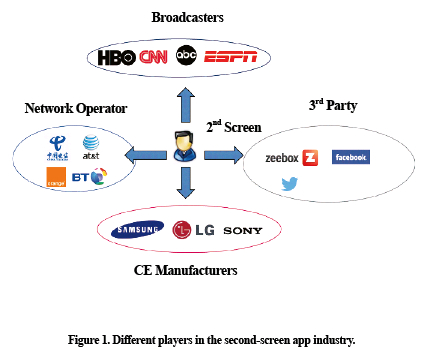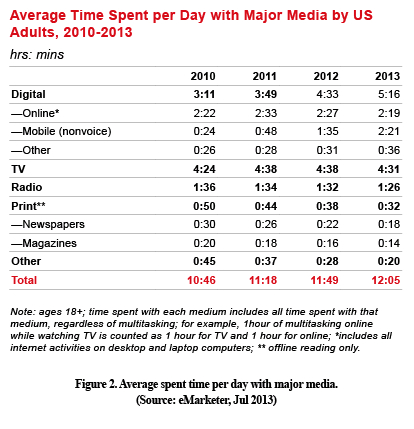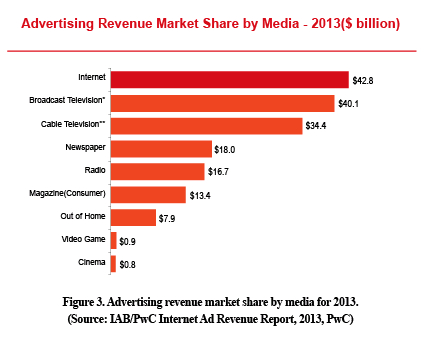Second Screen Nearing Center Stage
Second screen broadly refers to the usage of portable devices such as smart-phones and tablets when the end-user is watching main screen. Such usage is often related to the TV programs being watched on the primary screen, for example, looking up IMDb1 the movie being aired.
Second-Screen Usage
People often multitask while watching TV, which doesn’t necessarily require full user attention. Thirty percent of Americans say they do something else while watching TV, and only fourteen percent say they don’t do any other activity while watching TV2.
As mobile devices become more integrated into people’s lives, the number of screens per household is exploding. According to the most recent report from GfK/Mediametrie, there were 6.4 screens per household in France in 2013. This may lead to more “distraction” while watching the main TV. Various statistics give that around 70% of end-users are using mobile devices while watching TV, but only 15% of those activities are related to the main screen. This is driven by many factors, including people’s desire to share the TV experience (rather than view in isolation), to access more information, and to participate in discussions about TV programs.
The activities can be categorized as3:
● control and access: using a mobile device as an enhanced remote control, with additional functions, such as screen-casting
● search and discovery: leveraging the handy user input associated with mobile device
● contextualized enhancement: presenting additional information related to the TV program being watched.
Second screen service can be provided by different players:
● broadcasters. As content providers, broadcasters have full control of content and can create special apps for a TV channel or specific program (often an extremely popular program). An example of this is the TF1 app in France or American Idol app from Fox.
● pay TV operators. These operators provide a standalone application on devices along with extended functionality for controlling the STB. An example of this is the U-verse app from AT&T.
● CE manufacturers. With complete control of the hardware stack, a CE manufacturer can provide an associated application for controlling the device and exchanging content between screens (e.g., Samsung SmartView).
● third-party apps. These apps include SNS for discussing current TV programs. For example, as many as 33% of Twitter users tweet about shows they have watched. Others look to enhance the program metadata and social network feeds to provide a better social TV experience or to provide certain unique features, such as content recognition (e.g., Shazam for TV).

Second-Screen Technologies
One of the main building blocks of second-screen service is linking and interoperation of the main screen and second screen. This interconnection can be either direct, via a home network, or indirect, via a back end.
The link is direct when both the main and second screens are in the same home network and are linked either via Ethernet, WiFi or Powerline Communication. The second screen can then discover and use services offered by the main screen through UPnP, DLNA, Airplay, Mircast, DIAL, or proprietary protocols.
The link is indirect when a back-end entity relays commands from the second screen to the main screen. This is used in out-of-home scenarios, e.g., scheduling DVR on the go.
The Impact of Second-Screen
Second-screen is a new way of interacting with TV programs and engaging the audience. The impact of second-screen on viewer engagement with TV programs is evidenced by the increase in SNS activity during TV programs. During the 86th Academy Awards in 2014, Ellen Degeneres tweeted a selfie which was re-tweeted a record 3.4 million times. It is widely believed that Twitter has helped the Oscars net the highest TV ratings since 2000.

The amount of time that the average American viewer spends watching TV every day has remained constant since 2010 (Fig. 2). However, the use of mobile devices is consuming a significantly larger amount of our time every day. This has come at the expense of print media. Second screens provide precious opportunities to engage audiences and draw attention to the main screen.
TV still has the lion’s share of U.S. advertising revenue, bringing in $74.5 billion in 2013. In the same year, the internet brought in $42.8 billion (Fig. 3).

Second-Screen in Perspective
Despite the large number of second-screen services and the battle for the viewer’s attention, the main screen still dominates in terms of reach, impact and accountability. The Voice (TF1 France) may attract an audience of 7 million on a Saturday night, but only a fraction of those viewers are downloading and using the related app. Eyeballs are still focused on the main screen.
Also, the second-screen business model is still nascent: Twitter’s partnership program allows brands to send promotional tweets when you begin tweeting about a TV show. If TF1 knows you’re tweeting about The Voice, it can insert a promotional tweet into your feeds. Facebook and Nielson have partnered to provide a privacy-aware way of measuring video viewing on mobile devices.
However, with the increasing penetration and usage of mobile devices in households, viewers will increasingly shift their attention to second screens. Increasingly, people are spending more time on mobile devices, and the amount of time they spend watching TV is stagnating. The marketing potential of innovative interaction, i.e., much more engaging, personalized, contextualized viewing and interaction, is enormous. ZTE believes that the continually improved, unified experience created by second-screen will bolster advertising revenues generated by these screens, and one day they may no longer be referred to as “second” screens.
We are witnessing unprecedented technological changes that are impacting consumer behavior, content form, and business models. Second-screen usage should be so effortless and intuitive that it becomes part of a seamless multiscreen TV experience, as hinted by the embrace of Chromecast in the market. Second screen will likely be a disruptive force in the years ahead.
References:
[1] http://www.imdb.com
[2] http://www.harrisinteractive.com/NewsRoom/HarrisPolls/tabid/447/mid/1508/articleId/818/ctl/ReadCustom%20Default/Default.aspx
[3] Assessing the impact of second screen, http://stakeholders.ofcom.org.uk/market-data-research/other/technology-research/2014/second-screen